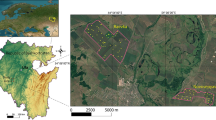Abstract
Solonetzic soils are widespread in the south of Ukraine; some of them are represented by low-sodium solonetzes whose diagnostics is complicated by the absence of correspondence between the low content of exchangeable sodium and the clearly pronounced features of the illuvial solonetzic horizon. The statistical treatment of available literature, personal materials, and the materials of soil surveys in the south of Ukraine demonstrated that the diagnostics of low-sodium solonetzes should be based on the assessment of the degree of illuviation in the soil profile. It was shown that the degree of correlation between the content of exchangeable sodium and the degree of illuviation of the soil profile varies in dependence on the size of the statistical sample and differs for the low-sodium and medium-sodium solonetzes. Two scales characterizing the degree of soil illuviation were developed for these soil groups. It is suggested that these scales should be applied during soil surveys in the areas with solonetzic soils.
Similar content being viewed by others
References
N. B. Vernander, “Soils of the Southern Ukraine,” Pochvovedenie, No. 4, 10–19 (1957).
I. N. Gogolev and I. I. Voloshin, “Diagnostic Indices and Classification Principles of Solonetzic Soils,” in Reclamation of Solonetzes: Proceedings of the All-Union Scientific and Technical Workshop on the Reclamation of Solonetzes (Kustanai, 1968), Part 1, pp. 206–215 [in Russian].
G. S. Grin’, Halogenesis of Loess Soils of Ukraine (Urozhai, Kiev, 1969) [in Russian].
V. P. Gusev and V. T. Kolesnichenko, “Soils of the Crimea Integrated State Agricultural Experimental Station and Adjacent Regions,” Tr. Krymskoi Gos. Kompl. S-Kh. Opyt. Stantsii 1, 21–47 (1955).
Yu. E. Kizyakov, Extended Abstract of Doctoral Dissertation (Moscow, 1975), pp. 3–64 [in Russian].
V. D. Kisel’, “Chernozems of the Temperate Continental East-European Zone (Ordinary Chernozems),” in Chernozems of the USSR (Ukraine) (Kolos, Moscow, 1981), pp. 96–122 [in Russian].
V. D. Kisel’, “Genesis of Solonetzic Soils in Ukraine,” Pochvovedenie, No. 12, 16–22 (1981).
P. G. Kovalivnich, Extended Abstract of Candidate’s Dissertation in Agriculture (Kharkov, 1963).
Methodological Recommendations on the Reclamation of Solonetzes and Survey of Saline Soils (Kolos, Moscow, 1970), p. 112 [in Russian].
A. V. Novikova and P. G. Kovalivnich, “Correlation between the Degree of Solonetzicity and the Degree of Illuviation in Solonetzic Soils of the Sivash Region, Crimea,” in Reclamation of Solonetzes: Proceedings of the All-Union Scientific and Technical Workshop on the Reclamation of Solonetzes, 1967 (Moscow, 1968), Part 1, pp. 216–227 [in Russian].
A. V. Novikova, “Geochemical Features and Regimes of Salt Accumulation in the Crimean Steppe, Methods of Improving Solonetzic Soils, and Possibility of Land Irrigation,” Tr. Khar’kov. S-Kh. Inst. 39, 241–350 (1962).
A. V. Novikova and A. M. Pyatakova, “Suitability of Solonetzic Soils for Deep Reclaiming Tillage in Relation with the Occurrence Depth of Carbonates,” in Theoretical Principles and Practice of Tillage and Chemical Reclamation of Solonetzic Soils (Tselinograd, 1982), pp. 48–55.
Development of Solonetzic Soils, Ed. by A. V. Novikova (Urozhai, Kiev, 1984) [in Russian].
N. I. Polupan, et al., Soil Atlas of the Ukrainian SSR, Ed. by N. K. Krupkii and N. I. Polupan (Urozhai, Kiev, 1979) [in Russian].
N. I. Polupan, “Southern Chernozems,” in Chernozems of the USSR (Ukraine) (Kolos, Moscow, 1981), pp. 122–151 [in Russian].
N. I. Polupan, A. F. Nesterenko, and V. D. Kisel’, “Recent Solonetzic Process in Soils of Southern Ukraine,” Pochvovedenie, No. 11, 10–16 (1979).
Field Guide of Soils, Ed. by N. I. Polupan, B. S. Nosko, and V. P. Kuz’michev (Urozhai, Kiev, 1981) [in Russian].
G. N. Sambur, V. I. Drobot, and F. D. Yankulina, “Solonetzes of the Ukrainian Dry Steppe and Their Improvement by Trenching,” in Problems in Solonetz Reclamation (Akad. Nauk SSSR, Moscow, 1958), pp. 119–175 [in Russian].
A. N. Sokolovskii, “Phenomena Related to Soil Colloids,” in Selected Works (Urozhai, Kiev, 1971), pp. 10–118 [in Russian].
V. M. Fridland, V. A. Nosin, A. F. Bol’shakov, et al., “Classification of Solonetzes,” in Methods of Improving the Reclamation of Solonetzes (Kolos, Moscow, 1976), pp. 46–54 [in Russian].
V. D. Kisil’, “Agrosoil Regions of the Chernozemic Steppe Zone,” Zb. Agrokhim. Gruntozn., No. 12, 109–142 (1969).
G. V. Novikova, “Agrosoil Regions of the Steppe Crimea,” Zb. Agrokhim. Gruntozn., No. 12, 152–257 (1965).
M. I. Polupan, V. B. Solevei, and V. A. Velichko, Classification of Ukrainian Soils (Agrarna Nauka, Kiiv, 2005) [in Ukrainian].
Author information
Authors and Affiliations
Additional information
Original Russian Text © A.V. Novikova, 2007, published in Pochvovedenie, 2007, No. 7, pp. 811–822.
Rights and permissions
About this article
Cite this article
Novikova, A.V. On the manifestation of solonetzic properties in soils of the steppe and dry steppe zones in the south of Ukraine. Eurasian Soil Sc. 40, 729–739 (2007). https://doi.org/10.1134/S1064229307070046
Received:
Issue Date:
DOI: https://doi.org/10.1134/S1064229307070046



